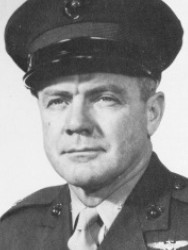VALENTINE-HERBERT
HERBERT JAMES "VAL" VALENTINE

MAJ

A FLYING SERGEANT
Herbert James Valentine was born on September 12, 1917, in Seattle, Washington. Shortly after the commencement of World War II he enlisted in the Navy, and after flight training, he was designated a Enlisted Naval Aviation Pilot (NAP) in May 1942. Sometime thereafter he accepted a temporary appointment as a commissioned officer as historical records reflect that on May 25, 1945, he was a Captain piloting a Corsair F4U with Marine Fighting Squadron 312 (VMF-312) in the Ryukyu Islands area. On this occasion he was leading a flight that engaged a numerically superior flight of Japanese planes, successfully shot down five of the Japanese planes and assisted in the destruction of another. In a later engagement he was credited with assisting in the destruction of another Japanese plane and thus became a World War II Ace, credited with shooting down six enemy aircraft. For his actions he was awarded the Navy Cross.
Valentine left the Marine Corps after World War II but returned to active service with his enlisted rank of Master Sergeant during the Korean War. An article in the November 2017 issue of Leatherneck Magazine concerning Enlisted Marine Corps Pilots reported that during the war Valentine was once flying a spotter plane low along a road when he spotted two well-camouflaged tanks. He pushed his plane into a dive and made two treetop-level passes to check the status of the tanks. He confirmed they were definitely unfriendly as they fired at him both times he passed, damaging his plane. MSGT Valentine warned an approaching U.N. column of the danger, then directed the tanks’ destruction by a ground unit. During the early part of the Korean War, MSGT Valentine was shot down behind enemy lines while flying a spotter plane. He was successful in evading enemy searchers and managed to find his way back through enemy lines to fly again. A few months later, he crash-landed while attempting to evacuate a wounded marine from a makeshift field that was surrounded by enemy troops. Both Valentine and his passenger managed to evade capture and escaped the scene without injuries.
In 1952 he was reportedly commissioned a Major. He retired at that rank in 1965 and returned to his home in Seattle. He died at the age of 78 on May 3, 1996 and is buried at Calvary Cemetery in Seattle where his grave marker carries the inscription: MAJ – USMC – WORLD WAR II – KOREA - NAVY CROSS.
NAVY CROSS CITATION
The President of the United States of America takes pleasure in presenting the Navy Cross to Captain Herbert James Valentine (MCSN: 0-10561), United States Marine Corps Reserve, for extraordinary heroism and distinguished service in the line of his profession as Division Leader and a Pilot in Marine Fighting Squadron THREE HUNDRED TWELVE (VMF-312), Marine Air Group THIRTY-THREE (MAG-33), FOURTH Marine Aircraft Wing, in aerial combat against enemy Japanese forces in the Ryukyu Islands Area, on 25 May 1945. Leading his division in a bold attack against a numerically superior force of enemy fighter and bomber aircraft, Captain Valentine skillfully maneuvered his plane for maximum striking power and, pressing home his attack, shot down five of the hostile planes, probably destroyed a sixth and assisted in the destruction of another. By his courageous leadership and indomitable fighting spirit, he aided materially in the destruction of the entire Japanese group, thereby preventing damage to friendly ships and airfields. His skilled airmanship and devotion to duty were in keeping with the highest traditions of the United States Naval Service.
Submitted by CDR Roy A. Mosteller, USNR (Ret)

